Edit Incidents
Merge, snooze, add Notes to incidents and more
When an incident triggers, there are a number of manual actions you may wish to take, depending on your workflow or the specifics of the situation:
- Merge Incidents
- Snooze an Incident
- Edit Incident Title
- Edit Incident Priority
- Edit Incident Urgency
- Reassign an Incident's Service
- Edit Incident Duration
- Add a Note to an Incident
- Define Technical Service Dependencies
Merge Incidents
Merging multiple incidents into a single incident streamlines the notification and resolution process. Merging incidents also consolidates alert information into a single incident, helping responders identify an issue’s root cause and impact.
Alert Maximum
An incident cannot have more than 1,000 alerts. This means that you will not be able to merge incidents if their combined total exceeds 1,000 alerts.
Web App
There are two places to merge incidents in the web app:
On the Incidents Page
If there are two or more triggered incidents on the Incidents page, you can merge them into a single incident. When you merge incidents, they will appear as a single incident with multiple alerts.
- On the web app’s Incidents page, select the checkboxes next to the incidents you’d like to merge together.
- Click Merge Incidents.
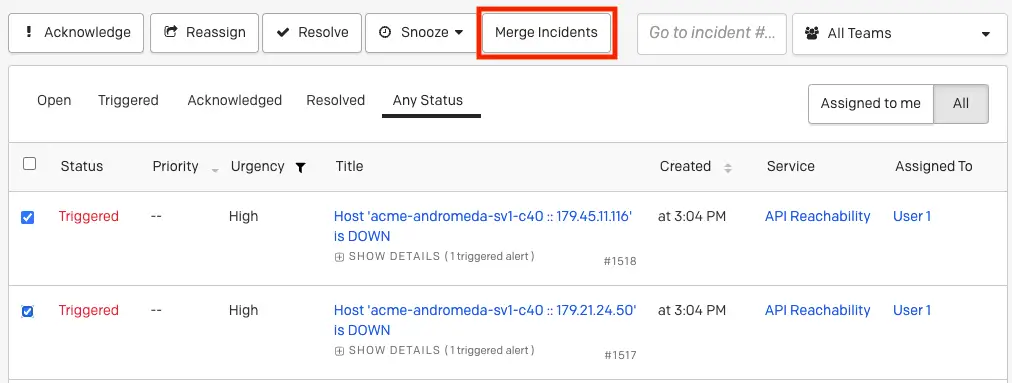
Merge incidents on the Incidents page
- In the modal, select which incident you would like alerts to be grouped under.
- In the field Select the incident to merge into, you can sort by Selected Incidents, Assigned to me, or Assigned to my team. After selecting an incident, you can optionally update the Incident Title, if a different title would more accurately describe the issue.
- Click Merge incidents and [X] Alerts.
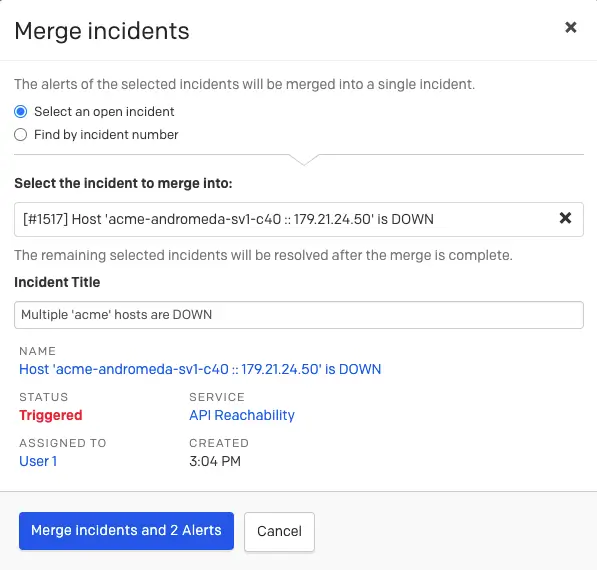
Merge Incidents and 2 Alerts
The incident dashboard will then show a single incident. When you select the incident to view its detail screen, you can review alerts from all incidents you selected in step 1 under the Alerts section.

Merged incident
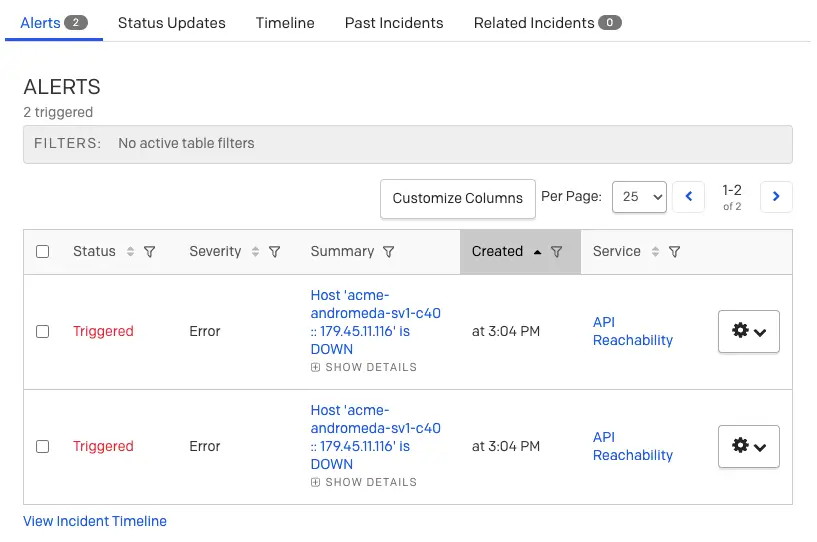
Merged alerts
On an Incident’s Details Page
You can also merge incidents on an incident’s details page:
- Select an incident to view its details page, then click More Merge with Another Incident.
- Enter an incident number and click Find Incident.
- Click Merge Incident and [X] Alerts.
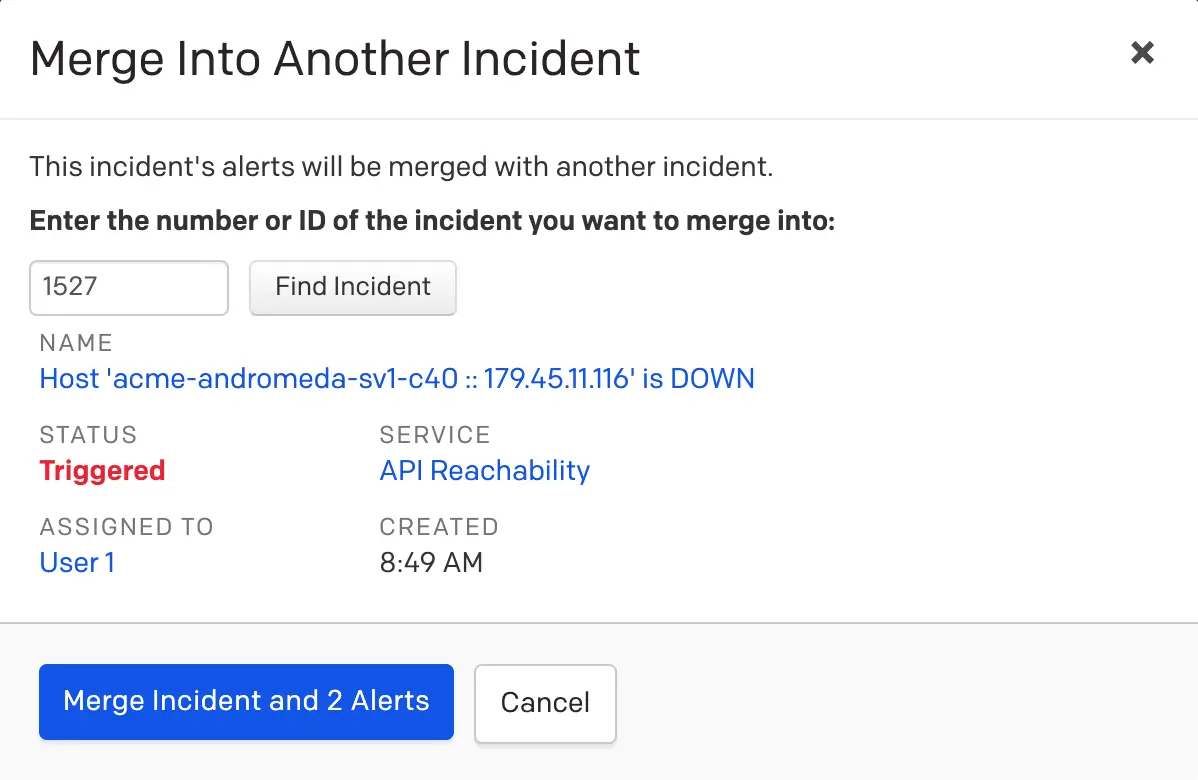
Merge incidents on the details page
Mobile App
- On the Open Incidents screen, tap (iOS) / (Android) in the top right and tap Select Incidents.
- Select the radio buttons to the left of the incidents you would like to merge, tap Change (X) Merge X incidents (iOS) or Merge (Android).
- Select the incident that you would like to merge into. You will see a confirmation dialog at the bottom of the screen stating that the incidents are now merged.
Merge Behavior
- When you merge multiple incidents together, alerts will be consolidated into the target incident. The other selected incidents will be resolved, with the resolution reason listed as Merged. These incidents will reference the target incident that you selected in the merge dialog.
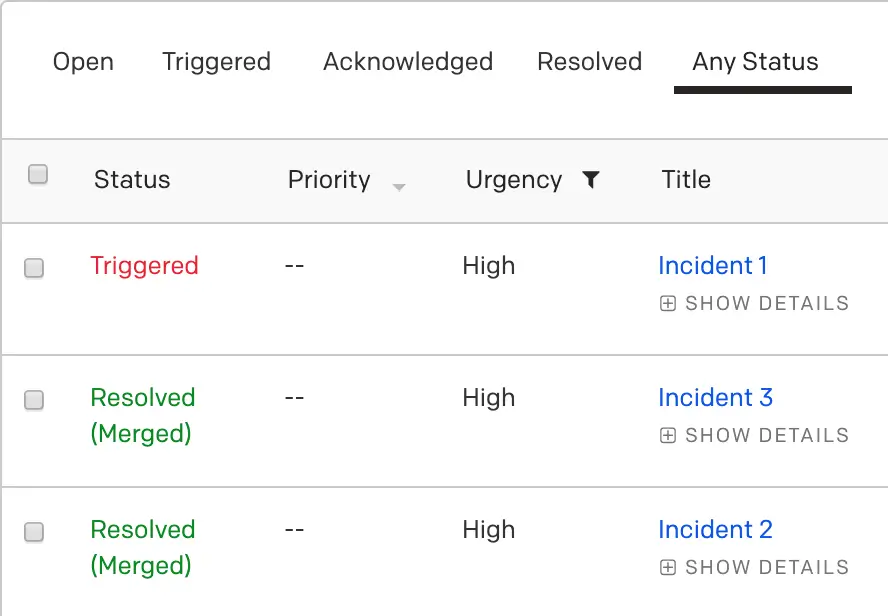
Merged incidents
- The deduplication key, called the Alert Key, will not change, but it will move so that it is under a single incident with other deduplication keys.
- If you are using a bidirectional integration, such as the Slack integration, merged incidents will display as resolved and reference the new target incident where all alerts are aggregated.
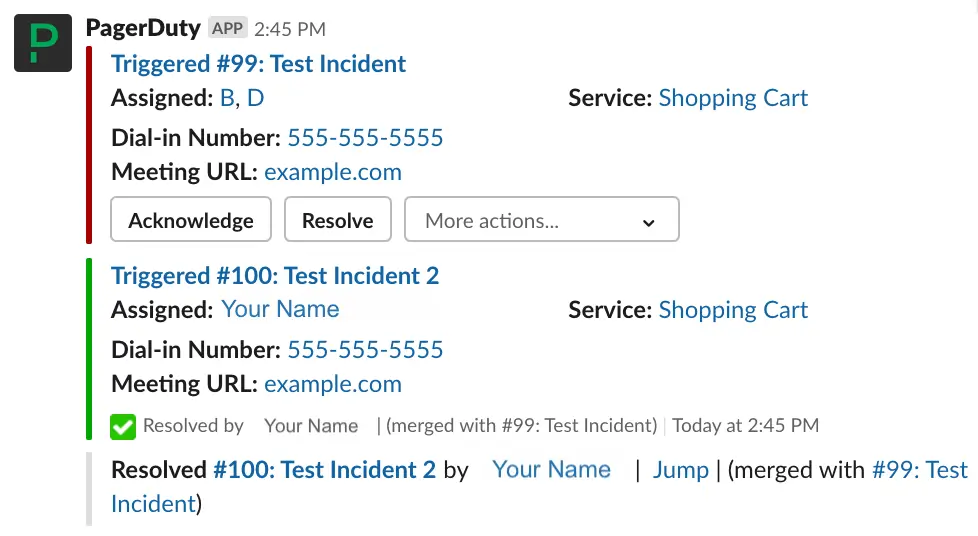
Merged incident in Slack
- Responders from source incidents will not be merged into the target incident. Instead, the target incident’s responders are preserved and all alerts will be assigned to them. You can view these users in the Timeline tab on the incident's details page.
- Subscribers from source incidents will not be merged into the target incident. They will need to be re-added to the target incident.
Move Alerts to Another Incident
If an alert is incorrectly merged, there are two ways to move alerts either to a new or existing incident:
On the Incident’s Page
You can move an alert to another incident on an incident’s details page in the web app:
- Navigate to an incident’s detail page and scroll to the Alerts section.
- Next to the alert that you’d like to move, select Move to a new incident or Move to an existing incident.

Move alerts on the Incidents page
- Confirm your selection in the modal that appears.
On an Alert’s Page
You may also move an alert to another incident on an alert’s details page in the web app:
- Navigate to an incident’s detail page in the Alerts section, click an alert’s Summary to navigate to its details page.
- Click Move to Another Incident.

Move alert to another incident
- Enter an incident number and click Find Incident.
- Click Move Alert.
Merged Incidents and Webhooks
If you have configured webhooks, merging alerts into another incident will send a webhook for the source incident with a resolve_reason of merged.
Webhooks will continue to update the target incident, but all incidents that were merged into the target incident will be updated as resolved.
Similarly, webhook updates will only be sent for services with open incidents. For example, if an incident from Service A is merged into an incident on Service B, only webhooks on Service B will continue to be sent.
For incidents that were resolved when they merged into a target incident, resolve webhooks will trigger, if configured. These incidents will contain a reference to the target incident. In the webhook body, the resolve_reason object will detail information about the target incident and indicate that the type is merge_resolve_reason.
Snooze an Incident
Responders can use the snooze feature to keep an acknowledged incident from escalating while they’re working on the issue. Users can snooze an incident for the following time intervals: 1 hour, 4 hours, 8 hours, 24 hours or Other. If you choose Other, the maximum length is 168 hours (i.e., one week).
Snooze is only available for acknowledged incidents. If a user does not resolve the incident before the snooze timer expires, the incident will return to a triggered state and will notify the user again according to their notification rules. If a different user has come on call since the incident triggered (e.g., due to a rotation on a schedule), both users will be notified.
The incident log captures all snooze actions taken on an incident.
Web App
- Acknowledge the incident. Acknowledge will be replaced with Snooze.
- Select Snooze and the length of time you’d like to snooze the incident.
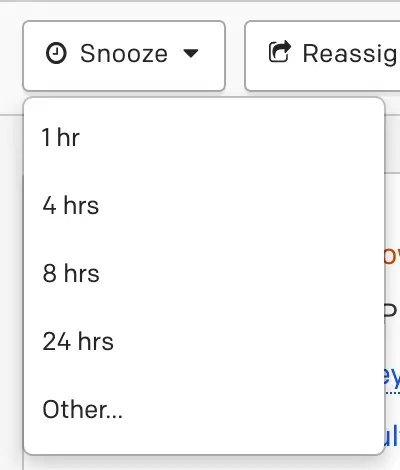
Snooze an incident
Add an Escalation Policy as a Responder
If a user adds responders to an incident and selects an escalation policy, snoozing will not prevent the incident from escalating.
If a user selects Other, they will have the option to select a custom snooze time, snooze until a time tomorrow, or base your snooze on a service’s support hours.
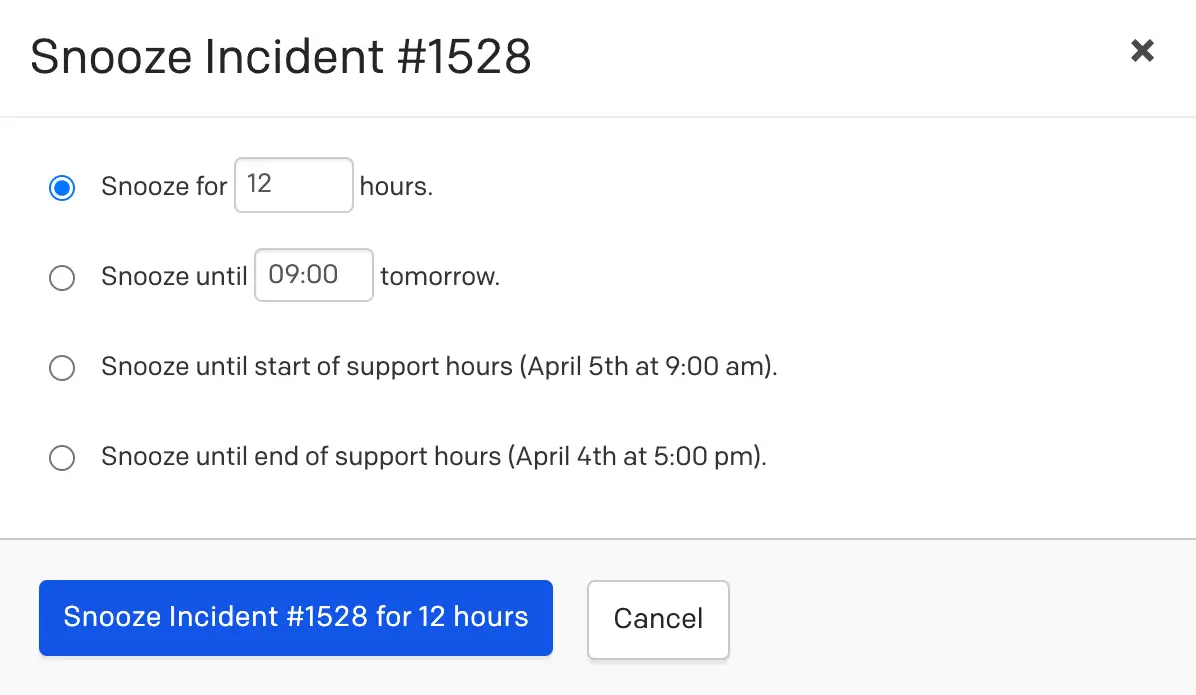
Snooze an incident
Mobile App
- Acknowledge the incident. Acknowledge will be replaced with Snooze.
- Select Snooze and the length of time you would like to snooze the incident:
- 1 hour
- 4 hours
- 24 hours
- for
- until

Snooze an incident in the mobile app
Reassign a Snoozed Incident
Reassigning a snoozed incident will cancel the snooze timer. The acknowledgement timeout will reset to the triggering service’s default value.
Acknowledge a Snoozed Incident
If another user acknowledges a snoozed incident, the incident exits the snoozed state and the acknowledgement timeout resets.
Auto-Resolution and Snooze
Services can be configured to automatically resolve an incident after a predetermined period of time passes — this is called auto-resolution. If an incident is snoozed past the time when auto-resolution would have resolved the incident (e.g., auto-resolution is configured to resolve incidents after six hours, but the incident is snoozed for 12 hours), the incident will remain snoozed and not automatically resolve. Additionally, when an incident returns to an acknowledged or triggered state, the auto-resolution timer resets.
Edit Incident Title
It may be occur that you will need to change an incident’s title as it progresses or as the nature of the underlying issue becomes more clear.
Web App
- Select an incident’s Title to navigate to its details page.
- To the right of the incident’s title, click Edit.
- Update the title.
- Click Save.
Mobile App
- Select an incident to navigate to its details page.
- With the Triage tab selected, tap Edit Title.
- Enter a new title.
- Tap Save.
Edit Incident Priority
Incident Priority lets responders know an incident's relative importance (e.g., P-1, P-2, etc.). Users can adjust an incident's priority if its impact grows or shrinks during the course of response, for example. Read Incident Priority for more information.
Edit Incident Urgency
If it becomes clear during the course of an incident that it should have a different urgency, responders can edit the urgency.
Editing Urgency Unacknowledges Incidents
If an incident is acknowledged and then its urgency is edited from low to high, then the incident will be unacknowledged. Escalation will then continue notifying responders using their high-urgency notification rules.
Web App
Select an incident’s Title to navigate to its details page.
- Next to Urgency, click the dropdown and select High or Low.

Edit incident urgency
Mobile App
- Select an incident to navigate to its details page.
- With the Triage tab selected, tap Change to Low/High Urgency.
- Confirm your selection by tapping Change Urgency.
Reassign an Incident's Service
Every PagerDuty incident has a Main Service as well as Impacted Services. The main service represents the technical service that the incident is assigned to. You can change an incident's main service by reassigning the incident to a different service.
An impacted service represents the services that are a part of an incident’s alert grouping. These services cannot be manually changed or reassigned.

An incident's main service and impacted services
A service is automatically included as an impacted service when one of the three following actions occur:
- Merging incidents that were created across multiple services into a single incident.
- Globally grouping alerts across multiple services into a single incident.
- Reassigning an incident's service. To ensure alert grouping continues after the reassignment across services, the alert group (including the alert key or deduplication key) does not change. The original service will remain as an impacted service due to alerts from the original service feeding into the incident.
Service Reassignment
Please keep the following in mind when assigning an incident to a different service:
- Acknowledged incidents will return to a triggered state.
- If the new service uses a different escalation policy, the current incident’s assignee will be removed from the incident and replaced with the on-call responder from the new service.
- Incident Roles, Incident Tasks, Custom Fields, and Incident Workflows will not be altered or affected.
- After reassigning the incident to a new service, the incident will continue to participate in Alert Grouping based on the originating service’s alert grouping settings.
- A record of the reassignment will appear in the incident's timeline, including the originating service and user who made the change.
You can assign an incident to a different service in the following locations:
Web App
Incident Details Page:
- Navigate to the Incidents page and click an incident's title to view its details.
- In the section Main Service, click to the right of the service’s name.

Edit icon
- In the modal window, select a service from the dropdown and click Change Service.
Operations Console:
Availability
The Operations Console is available with our PagerDuty AIOps add-on. If you would like to sign up for a trial of PagerDuty AIOps features, please read PagerDuty AIOps Trials.
- Navigate to AIOps Operations Console.
- Click the Incident Title or Alert to open up the side panel.
- In the Main Service section, click Edit to the right of the service’s name.
- In the modal window, select a different service from the dropdown and then click Change Service.
Mobile App
- In the PagerDuty mobile app, navigate to Incidents and then tap on an incident to see its details page.
- In the Triage tab, scroll left in the incident actions carousel and tap Change Service.
- Tap a service to select. You may select a service from the My Teams tab or All services tab.
- A confirmation modal will appear. Tap Confirm to reassign the incident to the new service.
ServiceNow
Prerequisites
- The Service Reassignment feature is available with ServiceNow 8.2. Please upgrade to the latest version to realize the full feature value.
- To configure Service Reassignment, please see Sync Service Reassignment with ServiceNow.
With ServiceNow 8.2, the Service Reassignment feature enables bidirectional sync between ServiceNow and PagerDuty when incidents are reassigned to different Configuration Items (CIs) in ServiceNow, and when incidents are reassigned to different services in PagerDuty.
To learn how to reassign in both systems, please see the following documentation:
- ServiceNow: Associate CIs with Incident
- PagerDuty: Reassign an Incident's Service
Note: Service reassignment isn’t available for Jira Cloud, Jira Server, or Zendesk integrations. If you reassign a linked PagerDuty incident to a different Technical Service, the incident remains linked to the issue or ticket, but synchronization rules tied to the original Technical Service will no longer apply.
Edit Incident Duration
Incident Status Requirement and Pricing Plan Availability
You can edit an incident’s duration once it is resolved. This feature is not available while an incident is triggered or acknowledged.
Accounts on all pricing plans are able to edit a resolved incident's duration. Adjusted incident durations can be viewed in Insights reports in the User Defined Response Effort. When this value is edited, it replaces the original Response Effort value for the incident, and is used for the Total response effort values seen in the Service Performance, Team, and Escalation Policy Insights reports.
PagerDuty tracks incident duration (how long it took to resolve an incident) in order to calculate metrics, such as Response Effort and MTTR (Mean Time To Resolve).
Sometimes the actual effort you spent on an incident may be different from the amount of time it was open. In order to provide more accurate metrics in your Intelligent Dashboards, you can adjust the incident duration to reflect the actual response effort that was required to resolve an incident.
Note: The User Defined Effort metric in the Incident Activity (Incidents List) report does reflect adjusted incident duration times.
Web App
- On an incident’s details page, click under Duration at the top right of the incident details page.
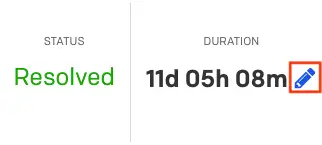
Edit incident duration
- In the modal, enter the Actual effort time that was required to resolve the incident in the following format:
xd xh xm. - Click Update Incident.
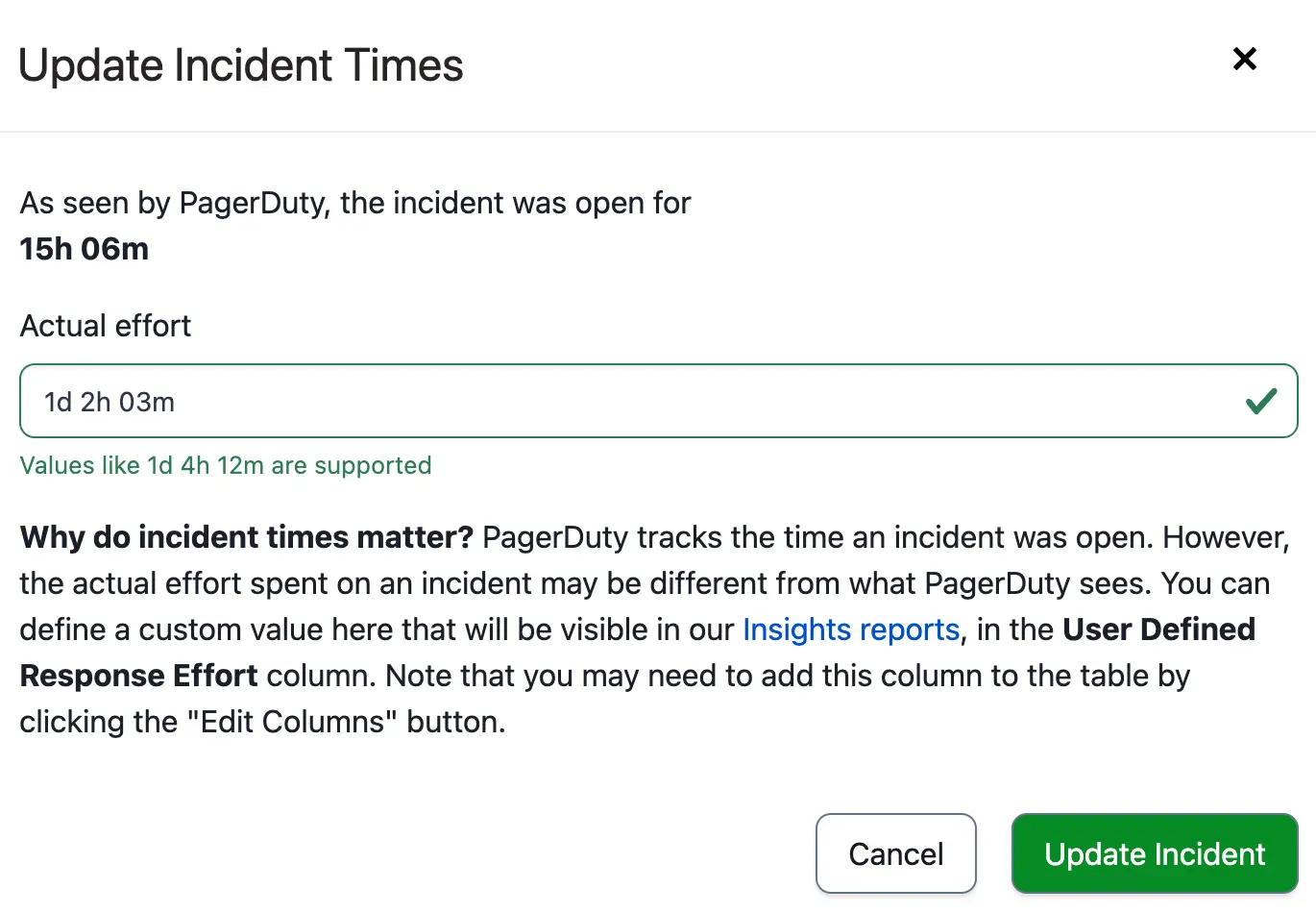
Update incident times
Edited Incident Durations in Insights Reports
The Insights feature will calculate Response Effort in the Service Performance, Team, and Escalation Policy reports using the edited incident duration, if it exists.
The Responder report does not use edited incident durations, since response efforts in this report are calculated based on responder activity, not incident activity.
Add a Note to an Incident
Incident notes help responders resolve incidents faster by adding relevant information or links. Notes can be useful for teams responding to active incidents, and they can add helpful context for later reference. Users can add notes to open and resolved incidents.
Incident Note Limitations
The following limitations apply to notes on both open and resolved incidents:
- An incident can have up to 2,000 notes.
- Incident notes are limited to 65,535 single-byte characters. This typically equates to ~16,000 characters of UTF-8 encoded text.
Web App
- On the Incidents page, select an incident’s Title to navigate to its details page.
- In the Notes section on the right-hand side, enter a note in the text field and click Add Note.
- To edit or delete a note, open the more actions (…) menu next to the note.
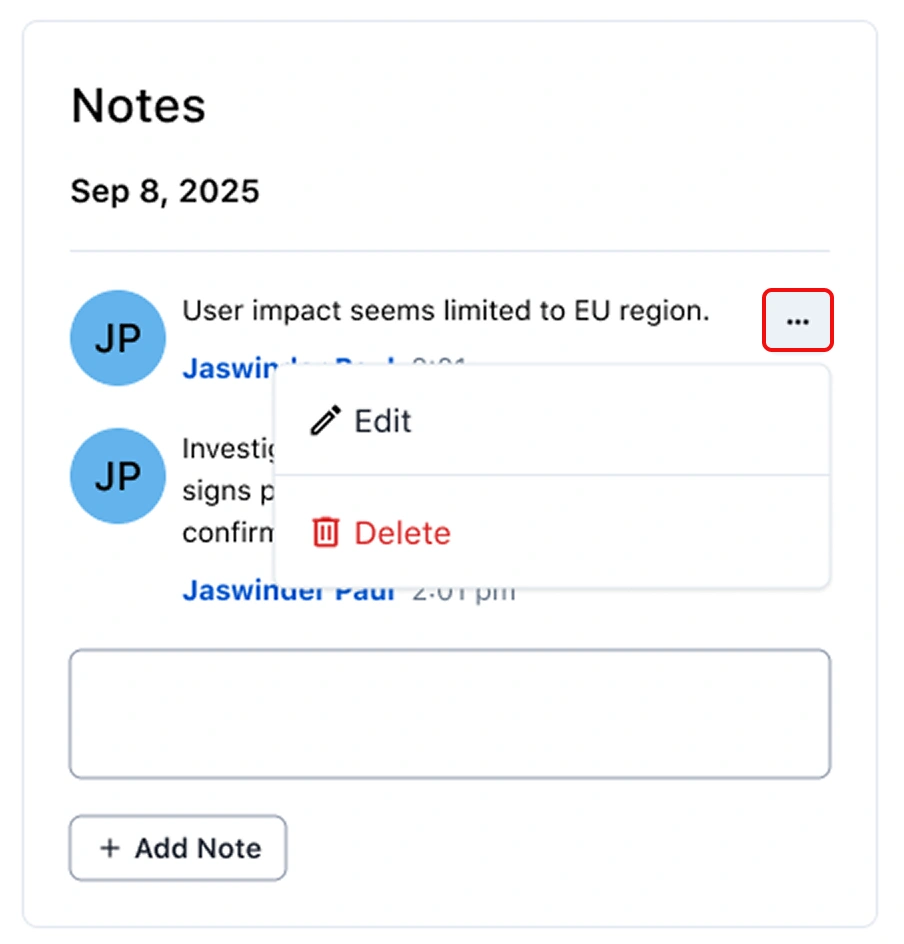
Edit a note in the web app
Mobile App
- Navigate to either Open Incidents or Resolved Incidents select an incident to navigate to its details screen.
- On iOS, tap More at the bottom of the screen. On Android, tap the menu icon in the top right corner.
- Select Add Note.
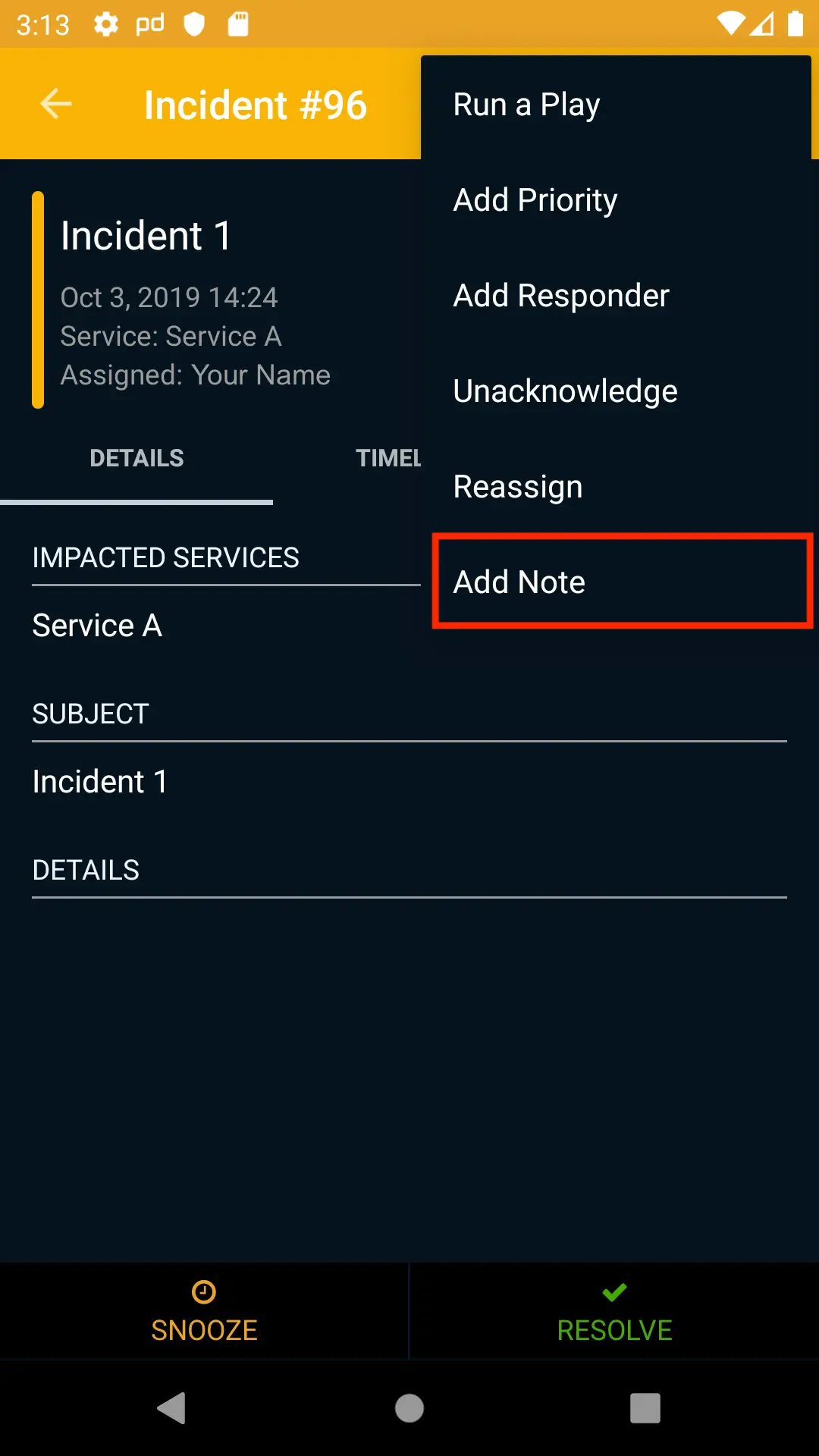
Add a note in the mobile app
- Enter the text for your note and tap Post Note.
Incident Workflows
Incident Workflows allow you to automate your response processes. The following Workflow Actions add incident notes to your workflows:
Event Orchestration
Availability
Adding notes using Event Orchestration is available as part of Advanced Event Orchestration. Please contact our Sales team if you are interested in changing your pricing tier.
You can automate adding notes to incidents as part of Event Orchestration. While configuring a Global or Service Orchestration Rule, select the Incident Data tab and enter your desired text in the section Add incident note.

Add a note using Event Orchestration
Like manually added notes, notes that are added as the result of an orchestration rule will appear on an incident's detail page under the Notes section. Notes added by Event Orchestration will show An Orchestration Event Rule as the note’s author.
Define Technical Service Dependencies
Service dependency data equips users with a broader understanding of the environment surrounding their incident, allowing them to identify the root cause more efficiently. When a service is experiencing an incident, and that service has dependencies defined, relevant service dependency data will be available on the incident details page. If the service does not yet have dependencies defined, or is missing possible dependencies, responders will be able to view suggested dependencies, and easily add them.
View Technical Service Dependencies in an Incident
To view the impacted service’s Technical Service Dependencies, click an incident’s Title to view the incident details page. You will see the Technical Service Dependencies section on the right, below Notes.
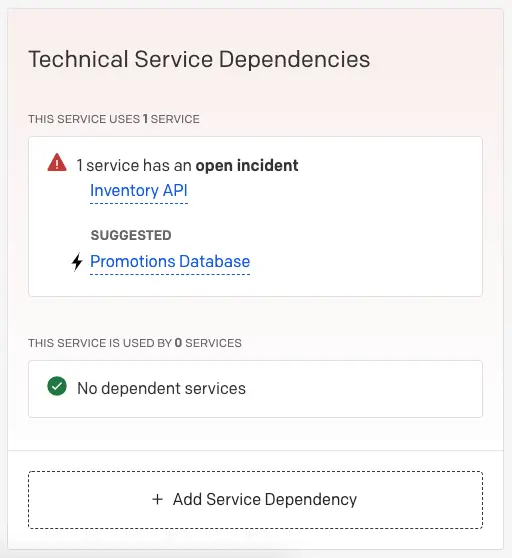
Technical service dependencies
Each dependency will have the following details:
- Service Name
- Status: Open Incidents or Operational (no open incidents).
If you click the dependency’s Service Name, you will be able to see more granular details:
- On Call Now: Responder(s) currently on call for the service.
- Open Incidents: A list of current open incidents on the service.
Suggested Technical Service Dependencies in an Incident
If incidents on your service tend to be followed by incidents on another service, or vice versa, suggested technical service dependencies will also be provided. If available, they will appear under a Suggested header with next to the service’s name:
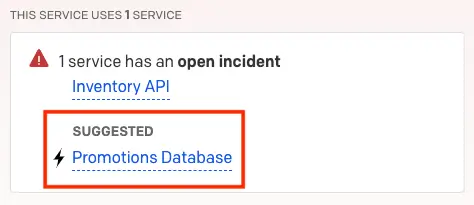
Suggested service
To add a Suggested Service Dependency, click the service name Add, next to Add this service as a dependency?.
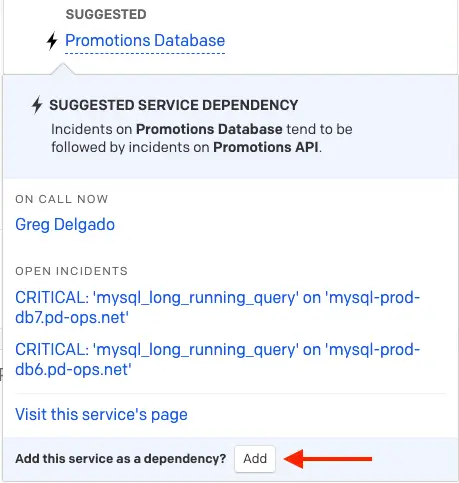
Add service as a dependency
Add Technical Service Dependencies From an Incident
- Click an incident’s Title to view the incident details page. You will see the Technical Service Dependencies section on the right, below Notes.
- Click Add Service Dependency.
- You will be directed to the service’s Service Dependencies page.
- There are two sections to this page: other services that this service uses or is used by. Click Edit Services to add the appropriate dependency.
- On the Edit Services screen, you may search by service name, or select one of the Business Services or Technical Services tabs. Click to add the desired services; you may add multiple business and technical services.
- Optional: You may also create a new business or technical service on this screen by clicking Create a new business service or Create a new technical service from the corresponding tabs. This will open the Business Service or Technical Service configuration screen in a new tab.
- Click Save Changes.
Updated about 1 month ago
